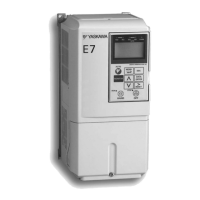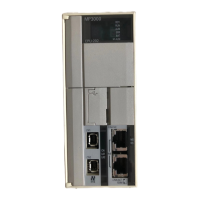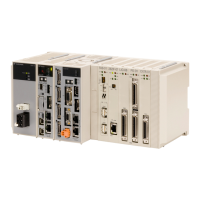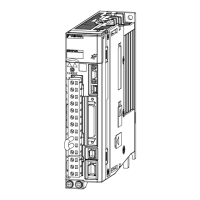6.10 Troubleshooting without Fault Display
YASKAWA ELECTRIC SIEP C710616 35D YASKAWA AC Drive E1000 Technical Manual 293
◆ Connected Machinery Vibrates When Motor Rotates
■ Unexpected Noise from Connected Machinery
Note: The drive may have trouble assessing the status of the load due to white noise generated from using Swing PWM (C6-02 = 7 to A).
■ Oscillation or Hunting
◆ PI Output Fault
◆ Motor Rotates After the Drive Output is Shut Off (Motor Rotates During DC Injection
Braking)
◆ Output Frequency is not as High as Frequency Reference
◆ Buzzing Sound from Motor at 2 kHz
Cause Possible Solutions
The carrier frequency is at the resonant frequency of the connected
machinery.
Adjust the carrier frequency using parameters C6-02 through C6-05.
The drive output frequency is the same as the resonant frequency
of the connected machinery.
• Adjust the parameters used for the Jump frequency function (d3-01 through d3-04) to skip the problem-causing
bandwidth.
• Place the motor on a rubber pad to reduce vibration.
Cause Possible Solutions
Insufficient tuning.
Perform Auto-Tuning.
Refer to Motor Performance Fine-Tuning on page 258.
Gain is too low when using PI control. Refer to b5: PI Control on page 145 for details.
The frequency reference is assigned to an external source and the
signal is noisy.
• Ensure that noise is not affecting the signal lines.
• Separate main circuit wiring and control circuit wiring.
• Use twisted-pair cables or shielded wiring for the control circuit.
• Increase the analog input time filter constant (H3-13).
The cable between the drive and motor is too long.
• Perform Auto-Tuning.
• Reduce the length of the cable.
Cause Possible Solutions
No PI feedback input.
• Check the multi-function analog input terminal settings.
• Set multi-function analog input terminal A1, A2, or A3 for PI feedback (H3-02, H3-10, or H3-06 = “B”).
• A signal input to the terminal selection for PI feedback is needed.
• Check the connection of the feedback signal.
• Check the various PI-related parameter settings.
• No PI feedback input to the terminal causes the value detected to be 0, causing a PI fault and the drive to operate at
max frequency.
The level of detection and the target value do not correspond with
each other.
• PI control keeps the difference between target and detection values at 0. Set the input level for the values relative to
one another.
• Use analog input gains H3-03 and H3-11 to adjust PI target and feedback signal scaling.
Reverse drive output frequency and speed detection. When output
frequency rises, the sensor detects a speed decrease.
Set PI output for reverse characteristics (b5-09 = 1).
Adjustment made to PI parameter settings are insufficient. Refer to b5: PI Control on page 145 for details.
Cause Possible Solutions
DC Injection Braking is set too low and the drive cannot decelerate
properly.
• Adjust the DC Injection braking settings.
• Increase the current level for DC Injection Braking (b2-02).
• Increase the DC Injection Braking time at stop (b2-04).
The stopping method is set so that the drive coasts to stop. Set b1-03 (Stopping Method Selection) to 0 or 2.
Cause Possible Solutions
Frequency reference is set within the range of the Jump frequency.
• Adjust the parameters used for the Jump frequency function (d3-01, d3-02, d3-03).
• Enabling the Jump frequency prevents the drive from outputting the frequencies specified in the Jump range.
Upper limit for the frequency reference has been exceeded.
• Set the maximum output frequency and the upper limit for the frequency reference to more appropriate values (E1-
04, d2-01).
• The following calculation yields the upper value for the output frequency = E1-04 × d2-01 / 100
Large load triggered Stall Prevention function during acceleration.
• Reduce the load.
• Adjust the Stall Prevention level during acceleration (L3-02).
Cause Possible Solutions
Exceeded 110% of the rated output current of the drive while
operating at low speeds.
• If the output current rises too high at low speeds, the carrier frequency is automatically reduced and causes a whining
or buzzing sound.
• If the sound is coming from the motor, disable carrier frequency derating (L8-38 = 0).
• Disabling the automatic carrier frequency derating increases the chances of an overload fault (oL2). Switch to a larger
capacity motor if oL2 faults occur too frequently.
SIEP_C710616_35.book 293 ページ 2015年11月30日 月曜日 午後2時2分
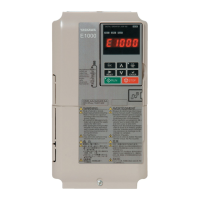
